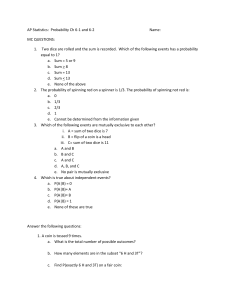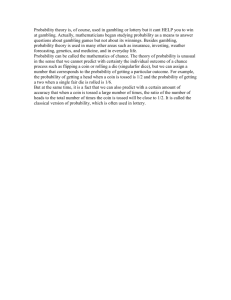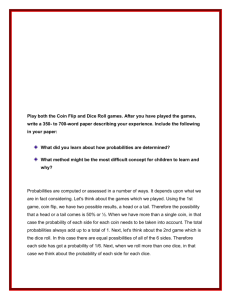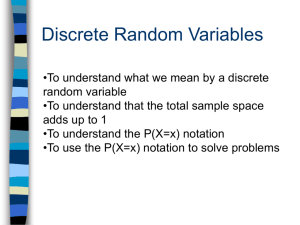Probability 12B
advertisement
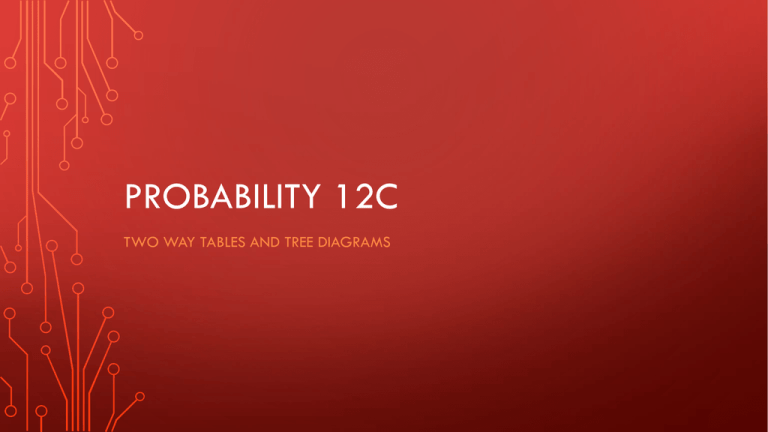
PROBABILITY 12C TWO WAY TABLES AND TREE DIAGRAMS TWO WAY TABLES • When more than one event has to be considered, a visual representation of the sample space is helpful in calculating the probabilities of various events. Two-way tables • A two-way table (sometimes referred to as a lattice diagram) is able to represent two events in a table form, when the two events occur at the same time • A two-way table for the experiment of tossing a coin and rolling a die simultaneously is shown in the following table. Possibilities for dice roll Possibilities for coin toss All possible outcomes/ combinations WORKED EXAMPLE • Two dice are rolled. The outcome is the pair of numbers shown. (a) Show the results on a two-way table. Dice 1 possibilities Dice 2 possibilities 1 2 3 4 5 6 1 1,1 1,2 1,3 1,4 1,5 1,6 2 2,1 2,2 2,3 2,4 2,5 2,6 3 3,1 3,2 3,3 3,4 3,5 3,6 4 4,1 4,2 4,3 4,4 4,5 4,6 5 5,1 5,2 5,3 5,4 5,5 5,6 6 6,1 6,2 6,3 6,4 6,5 6,6 (b) Calculate the probability of obtaining an identical ordered pair; that is, Pr[(1, 1), (2, 2), (3, 3), (4, 4), (5, 5), (6, 6)] Dice 2 possibilities 6 x 6 = 36 total possibilities How many ordered pairs are there? 6 Therefore, Pr(ordered pair) 6 1 = 36 = 6 Dice 1 possibilities How many total possibilities are there? 1 2 3 4 5 6 1 1,1 1,2 1,3 1,4 1,5 1,6 2 2,1 2,2 2,3 2,4 2,5 2,6 3 3,1 3,2 3,3 3,4 3,5 3,6 4 4,1 4,2 4,3 4,4 4,5 4,6 5 5,1 5,2 5,3 5,4 5,5 5,6 6 6,1 6,2 6,3 6,4 6,5 6,6 TREE DIAGRAMS • Tree diagrams are very helpful when there are multiple events; for example, when a coin is tossed twice. • These are events that happen one after the other, not at the same time (like two way tables) • Each stage of a multiple event experiment produces a part of a tree. • For example, this tree diagram shows the outcomes of a coin being tossed once, then tossed again • To work put the probability of these events occurring, multiply them together, e.g. Pr(HT) = 0.5 x 0.5 = 0.25 • When you add all the probabilities together, they should add to one WORKED EXAMPLE • Three coins are tossed simultaneously. Draw a tree diagram for the experiment. Calculate the following probabilities. • a Pr(3 Heads) b Pr(2 Heads) c Pr(at least 1 Head) • Three coins are tossed simultaneously. Draw a tree diagram for the experiment. Coin 1 H 1 2 1 2 Coin 2 1 2 1 2 T 1 2 1 2 H T Coin 3 1 2 1 2 1 2 1 2 H 1 2 1 2 T 1 2 1 2 H T H T H T H T HHH HHT HTH HTT THH THT TTH TTT • Calculate the following probabilities. a Pr(3 Heads) b Pr(2 Heads) c Pr(at least 1 Head) 1 2 1 2 1 2 (a) Pr(HHH) = x x = 1 8 1 8 1 8 1 8 (b) Pr(two H) = Pr(HHT) + Pr(HTH) + Pr(THH) = + + = (c) Pr(at least one H) = How many outcomes have at least one H? All except TTT Pr(TTT) = 1 8 1 8 1 – Pr(TTT) = 1 - = 7 8 3 8 WORKED EXAMPLE • The letters A, B, C and D are written on identical pieces of card and placed in a box. A letter is drawn at random from the box. Without replacing the first card, a second one is drawn. Use a tree diagram to find: a Pr(first letter is A) b Pr(second letter is B) c Pr(both letters are the same). • Three coins are tossed simultaneously. Draw a tree diagram for the experiment. First draw A Remember, the card is removed after the first draw, leaving the 3 leftover cards in the second draw 1 4 1 4 1 4 B C 1 4 Second draw 1 3 1 3 1 3 1 3 1 3 1 3 1 3 1 31 3 D 1 3 1 3 1 3 B C D A C D A B D A B C AB AC AD BA BC BD CA CB CD DA DB DC 1 1 1 1 1 1 1 1 1 1 1 1 Pr(AB) = 4 x 3 = 12 Pr(AC) = 4 x 3 = 12 Pr(AD) = 4 x 3 = 12 Pr(BA) = 4 x 3 = 12 1 1 1 4 3 12 1 1 1 Pr(BD) = 4 x 3 = 12 1 1 1 Pr(CA) = 4 x 3 = 12 1 1 1 Pr(CB) = 4 x 3 = 12 1 1 1 Pr(CD) = 4 x 3 = 12 1 1 1 Pr(DA) = 4 x 3 = 12 1 1 1 Pr(DB) = 4 x 3 = 12 1 1 1 Pr(DC) = 4 x 3 = 12 Pr(BC) = x = (a) Pr(first letter is A) = Pr(AA) + Pr(AB) + Pr(AC) + Pr(AD) = 1 12 = 3 12 + 1 12 = 1 4 + 1 12 (c) Pr(both letters the same) = Pr(AA) + Pr(BB) + Pr(CC) + Pr(DD) (b) Pr(second letter B) = Pr(AB) + Pr(CB) + Pr(DB) = 1 12 = 3 12 + 1 12 = 1 4 + 1 12 =0 QUESTIONS TO DO • Exercise 12C p410: 1, 3, 7, 8, 10, 11, 12
